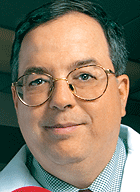Futuristic nanotechnology has been teamed with a decades-old drug to beat atherosclerotic plaques in new School of Medicine research.
The scientists have found that drug-laced nanoparticles plus a statin could stop the growth of tiny blood vessels that feed arterial plaques. Their results suggest that the dual treatment also prevents the vessels from restarting their growth, which could shrink or stabilize plaques. Although the data were obtained in tests on rabbits, they raise hope that a similar approach could help human patients with atherosclerosis.

The nanoparticles, minute spheres about 20,000 times smaller than the diameter of a straight pin, were coated with a substance that made them stick in growing blood vessels and with fumagillin, a potent compound that stops blood-vessel growth.
“We saw that statins sustain the acute inhibition of blood- vessel growth produced by the fumagillin nanoparticles within the plaque,” said senior author Gregory Lanza, M.D., Ph.D., professor of medicine and of biomedical engineering.
Lanza and co-senior author Samuel A. Wickline, M.D., professor of medicine, of physics, of biomedical engineering and of cell biology and physiology, published these results in the September issue of the Journal of the American College of Cardiology: Cardiovascular Imaging. Patrick M. Winter, Ph.D., research assistant professor of medicine, was the lead author of the study.
Patients with atherosclerosis often take statins to lower cholesterol. Statins also decrease atherosclerotic plaque progression by modestly inhibiting proliferation of new vessels (neovessels) within plaques. These neovessels provide increased blood and oxygen to cells in actively developing plaques.
Because of their high fragility, neovessels often rupture, leading to local hemorrhages that greatly accelerate the disease process. Fumagillin nanoparticles could be used to further inhibit the development of new vessel treatment in high-risk patients, Lanza said.
“Our past research showed that fumagillin nanoparticles reduced blood-vessel formation at the site of arterial plaques in experimental rabbits after one week,” Lanza said. “In this study, we tested how long that effect lasts and if it could be extended by statins.”
The rabbits used in the study ate a high-fat diet that caused arterial plaques. The researchers detected new blood-vessel buildup at the site of plaques by coating nanoparticles that were targeted to neovessels with an MRI contrast agent.
When the rabbits received a single dose of blood-vessel-targeted nanoparticles that also carried fumagillin, the researchers saw that the amount of MRI signal at the sites of plaques decreased about fivefold by the end of one week. But a high MRI signal returned by the fourth week, indicating that plaques were active again.
Because repeated injections of fumagillin nanoparticles is impractical for treating humans, the researchers looked for a way to extend the initial effectiveness.
Atherosclerotic rabbits that got daily doses of the statin atorvastatin (brand name Lipitor) had no change in plaque angiogenesis measured by MRI. When the statin and the fumagillin nanoparticles were started at the same time, the atorvastatin had no additional benefits over the targeted therapy.
However, when the statin had been given for at least one month prior to the fumagillin treatment, the fivefold reduction in MRI signal due to diminished neovessels was maintained for four weeks.
Lanza said that the results suggest that one or possibly two injections of nanoparticles in patients who are already on statins could lead to a long-term reduction in plaque activity and prolonged plaque stability.
“Because nearly half of patients experiencing their first heart attack die soon after, our goal is to prevent or greatly delay clinically significant atherosclerotic disease,” Lanza said. “We hope to achieve this by a personalized nanomedicine approach that risk-stratifies patients and affords safe, targeted delivery of potent compounds that block progression in high-risk patients.”